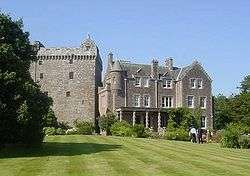Comlongon Castle

Comlongon Castle is a tower house dating from the 15th century. It is located 1 km west of the village of Clarencefield, 10 km south-east of Dumfries, in south west Scotland. The original tower was extended by the addition of a 19th-century baronial style mansion. The castle and mansion are now a hotel.
History
Thomas Randolph, 1st Earl of Moray granted the lands of Comlongon, in the early 14th century, to his nephew William de Moravia, ancestor of the Murrays of Cockpool. His descendant Cuthbert of Cockpool (d.1493) built Comlongon Castle in the later part of the 15th century, to replace the Murrays' earlier castle of Cockpool, of which only earthworks remain at Cockpool Farm, to the south west of Comlongon. His son John Murray (d. c.1527) was created Baron Cockpool in 1508. Descendants of the Murrays were later created Viscounts Stormont in 1621, and Earls of Mansfield in 1776, and Comlongon was part of the Earl's estate until 1984. The castle is reportedly haunted by the ghost of Lady Marion Carruthers who took her own life by leaping from the lookout tower.[1]
The castle
The red sandstone tower is approximately 15m by 13m, and 18m high to the corbelled parapet. It was built on a stone 'plinth', in order to support the structure on what was a marshy site. The entrance to the tower still retains the original yett, a portcullis-like metal grid in front of the door. This leads into a vaulted cellar with a well, and two spiral stairs leading up. The main stair at the north-east corner leads up to a caphouse at parapet level, while the second serves the high-table end of the first floor hall.
The hall is dominated by a large fireplace, with the Royal Arms of Scotland carved above it. Heraldic emblems are carved onto several projecting corbels, and an elaborately decorated recess or aumbry, with a carved cinquefoil surround, attests to the relative wealth of the Murrays. A separate fireplace at the opposite end of the hall would have served the narrow kitchen, and would have been separated from the hall by a timber screen where a wall now stands.
The most remarkable feature of Comlongon is the walls, over 4m thick in places, and riddled with numerous interconnecting chambers to an extent not seen in any contemporary Scottish castle. The narrow kitchen is one such mural chamber. Also within the walls off the hall is a guardroom, with a cell beyond, and a trapdoor which gives access to a grim unlit dungeon below.
Two further storeys lie above the hall, with parapet walks at roof level. The western parapet was roofed over before 1624, when a surviving inventory was taken, creating a gallery with crow-stepped gables. A similar structure was built over the south-east corner, giving the south facade a symmetrical appearance. The upper storeys were also subdivided before this time.
A walled courtyard and ditch, possibly a moat, once surrounded the tower, although this was removed in the early 18th century, when a manor house was added to the east side of the tower. Between 1890 and 1902 this manor was replaced by the present Scottish baronial mansion, by architects James Barbour & JM Bowie of Dumfries. The castle was bought by the present owners, from the Earl of Mansfield's estate, in 1984, and renovated to its current condition. It has been operated as a hotel since then.
References
- Coventry, Martin The Castles of Scotland (3rd Edition), Goblinshead, 2001
- Gifford, John The Buildings of Scotland: Dumfries and Galloway, Penguin, 1996
- Lindsay, Maurice The Castles of Scotland, Constable & Co. 1986
- Salter, Mike The Castles of South West Scotland, Folly Publications, 1993
- Steell, Geoffrey Dumfries and Galloway (2nd Edition), Stationery Office, 1996
- Historic Scotland Listed Building Report
External links
Coordinates: 55°0′24.95″N 3°26′26.89″W / 55.0069306°N 3.4408028°W